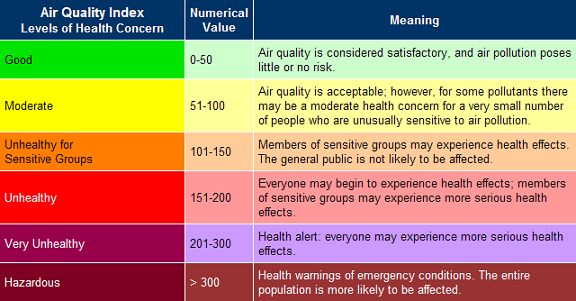What Do People With Asthma Need to Know About the Current Wildfires and Air Quality?
The Environmental Protection Agency’s (EPA) AirNow.gov program measures and reports the air quality across the United States. Air quality is measured by the number of small particles and harmful gases in the air. AirNow uses a color-coded chart to report the air quality. This is called the air quality index (AQI). AirNow also offers a fire map available at fire.AirNow.gov.

As of June 7, the air quality in the Northeast, Maryland, Virginia, and the District of Columbia was rated as unhealthy for everyone. Parts of Connecticut, New York, New Jersey, and Pennsylvania had very unhealthy and hazardous air quality.
Smoke from the Canadian wildfires stretched from the Ohio Valley to as far south as the Carolinas and northern Georgia. Air quality advisories have been in effect in Michigan, Minnesota, and Wisconsin in recent days.
Exposure to air particles in the smoke released during a fire can irritate your lungs. This can worsen your asthma symptoms. But there are steps you can take to help keep yourself safe.
How Can I Prevent or Manage Asthma Symptoms During Wildfires and Poor Air Quality?
Track the AQI in your area. You can get current readings on AirNow.gov, weather sites and smartphone apps, and from local news reports.
Keep your asthma under control as much as possible. Ask your allergist how you can prevent symptoms. They may have you increase your medicines and decrease outdoor physical activities while the AQI is high. Follow your Asthma Action Plan if you start to have symptoms. Know your asthma early warning signs and symptoms, as well as signs you need emergency asthma treatment.
Work and exercise inside while the AQI is high. Physical activity like exercise causes you to breathe faster and deeper, which pulls more polluted air deeply into your lungs. People who work outside are at risk of serious health effects from high levels of air pollution. If you must spend time outside, it is best to wear an N95-rated mask. Cloth masks and face coverings do not provide enough protection from wildfire air pollution. Cover both your mouth and your nose and protect your eyes.
Improve your indoor air quality. Since you will be spending more time indoors, it’s equally as important to make sure your indoor air quality is good. The polluted outdoor air can enter your home and get trapped there. Here are some ways you can improve your indoor air:
- Prevent outdoor air from coming inside your home. Keep your windows and doors closed when air quality is poor. If you have an HVAC system, turn off the fresh intake system and recirculate the indoor air. Check that the air filter is firmly in place. Follow the manufacturer’s instructions for cleaning or replacing the air filters. When selecting air filters, look for a MERV rating of 13 or above. Consider using CERTIFIED asthma & allergy friendly® air filters. These filters have been independently tested and confirmed to remove air pollution and other asthma triggers.
- Run a CERTIFIED asthma & allergy friendly® air cleaner in a room in your home. Place the air cleaner in the room(s) you spend the most time. Replace or clean the air cleaner’s filters according to instructions.
- Avoid using heavily scented products. Cleaners, candles, potpourri, and other fragranced products can worsen your indoor air quality and make your indoor air polluted.
- Use your kitchen and bathroom exhaust fans. A stove/oven hood with a fan can remove air pollution created by cooking. Bathroom fans are important to help remove moisture and prevent mold growth.
It is important to stay up to date on news about asthma and allergies. By joining our community and following our blog, you will receive tips about managing your health. Our community also provides an opportunity to connect with other people who manage these conditions for support.

Comments (1)